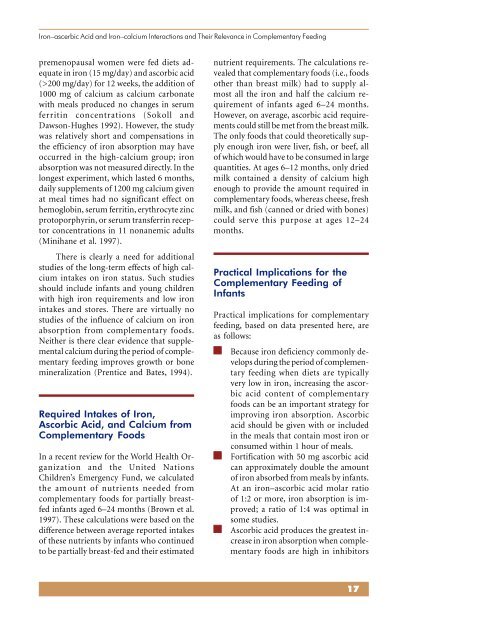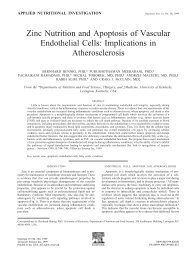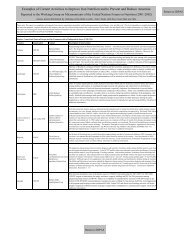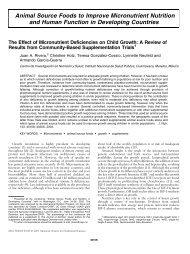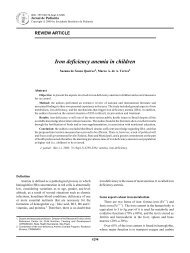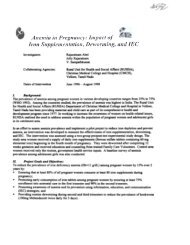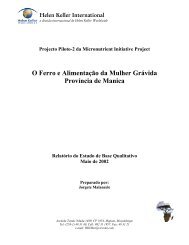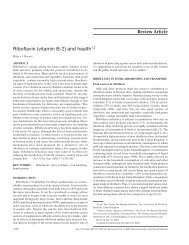Micronutrient Interactions: Impact on Child Health and ... - Idpas.org
Micronutrient Interactions: Impact on Child Health and ... - Idpas.org
Micronutrient Interactions: Impact on Child Health and ... - Idpas.org
Create successful ePaper yourself
Turn your PDF publications into a flip-book with our unique Google optimized e-Paper software.
Ir<strong>on</strong>–ascerbic Acid <strong>and</strong> Ir<strong>on</strong>–calcium <str<strong>on</strong>g>Interacti<strong>on</strong>s</str<strong>on</strong>g> <strong>and</strong> Their Relevance in Complementary Feeding<br />
premenopausal women were fed diets adequate<br />
in ir<strong>on</strong> (15 mg/day) <strong>and</strong> ascorbic acid<br />
(>200 mg/day) for 12 weeks, the additi<strong>on</strong> of<br />
1000 mg of calcium as calcium carb<strong>on</strong>ate<br />
with meals produced no changes in serum<br />
ferritin c<strong>on</strong>centrati<strong>on</strong>s (Sokoll <strong>and</strong><br />
Daws<strong>on</strong>-Hughes 1992). However, the study<br />
was relatively short <strong>and</strong> compensati<strong>on</strong>s in<br />
the efficiency of ir<strong>on</strong> absorpti<strong>on</strong> may have<br />
occurred in the high-calcium group; ir<strong>on</strong><br />
absorpti<strong>on</strong> was not measured directly. In the<br />
l<strong>on</strong>gest experiment, which lasted 6 m<strong>on</strong>ths,<br />
daily supplements of 1200 mg calcium given<br />
at meal times had no significant effect <strong>on</strong><br />
hemoglobin, serum ferritin, erythrocyte zinc<br />
protoporphyrin, or serum transferrin receptor<br />
c<strong>on</strong>centrati<strong>on</strong>s in 11 n<strong>on</strong>anemic adults<br />
(Minihane et al. 1997).<br />
There is clearly a need for additi<strong>on</strong>al<br />
studies of the l<strong>on</strong>g-term effects of high calcium<br />
intakes <strong>on</strong> ir<strong>on</strong> status. Such studies<br />
should include infants <strong>and</strong> young children<br />
with high ir<strong>on</strong> requirements <strong>and</strong> low ir<strong>on</strong><br />
intakes <strong>and</strong> stores. There are virtually no<br />
studies of the influence of calcium <strong>on</strong> ir<strong>on</strong><br />
absorpti<strong>on</strong> from complementary foods.<br />
Neither is there clear evidence that supplemental<br />
calcium during the period of complementary<br />
feeding improves growth or b<strong>on</strong>e<br />
mineralizati<strong>on</strong> (Prentice <strong>and</strong> Bates, 1994).<br />
Required Intakes of Ir<strong>on</strong>,<br />
Ascorbic Acid, <strong>and</strong> Calcium from<br />
Complementary Foods<br />
In a recent review for the World <strong>Health</strong> Organizati<strong>on</strong><br />
<strong>and</strong> the United Nati<strong>on</strong>s<br />
<strong>Child</strong>ren’s Emergency Fund, we calculated<br />
the amount of nutrients needed from<br />
complementary foods for partially breastfed<br />
infants aged 6–24 m<strong>on</strong>ths (Brown et al.<br />
1997). These calculati<strong>on</strong>s were based <strong>on</strong> the<br />
difference between average reported intakes<br />
of these nutrients by infants who c<strong>on</strong>tinued<br />
to be partially breast-fed <strong>and</strong> their estimated<br />
nutrient requirements. The calculati<strong>on</strong>s revealed<br />
that complementary foods (i.e., foods<br />
other than breast milk) had to supply almost<br />
all the ir<strong>on</strong> <strong>and</strong> half the calcium requirement<br />
of infants aged 6–24 m<strong>on</strong>ths.<br />
However, <strong>on</strong> average, ascorbic acid requirements<br />
could still be met from the breast milk.<br />
The <strong>on</strong>ly foods that could theoretically supply<br />
enough ir<strong>on</strong> were liver, fish, or beef, all<br />
of which would have to be c<strong>on</strong>sumed in large<br />
quantities. At ages 6–12 m<strong>on</strong>ths, <strong>on</strong>ly dried<br />
milk c<strong>on</strong>tained a density of calcium high<br />
enough to provide the amount required in<br />
complementary foods, whereas cheese, fresh<br />
milk, <strong>and</strong> fish (canned or dried with b<strong>on</strong>es)<br />
could serve this purpose at ages 12–24<br />
m<strong>on</strong>ths.<br />
Practical Implicati<strong>on</strong>s for the<br />
Complementary Feeding of<br />
Infants<br />
Practical implicati<strong>on</strong>s for complementary<br />
feeding, based <strong>on</strong> data presented here, are<br />
as follows:<br />
Because ir<strong>on</strong> deficiency comm<strong>on</strong>ly develops<br />
during the period of complementary<br />
feeding when diets are typically<br />
very low in ir<strong>on</strong>, increasing the ascorbic<br />
acid c<strong>on</strong>tent of complementary<br />
foods can be an important strategy for<br />
improving ir<strong>on</strong> absorpti<strong>on</strong>. Ascorbic<br />
acid should be given with or included<br />
in the meals that c<strong>on</strong>tain most ir<strong>on</strong> or<br />
c<strong>on</strong>sumed within 1 hour of meals.<br />
Fortificati<strong>on</strong> with 50 mg ascorbic acid<br />
can approximately double the amount<br />
of ir<strong>on</strong> absorbed from meals by infants.<br />
At an ir<strong>on</strong>–ascorbic acid molar ratio<br />
of 1:2 or more, ir<strong>on</strong> absorpti<strong>on</strong> is improved;<br />
a ratio of 1:4 was optimal in<br />
some studies.<br />
Ascorbic acid produces the greatest increase<br />
in ir<strong>on</strong> absorpti<strong>on</strong> when complementary<br />
foods are high in inhibitors<br />
17


